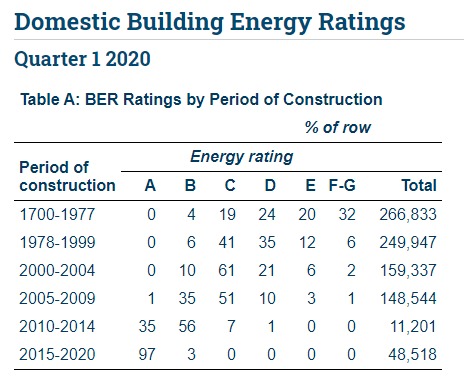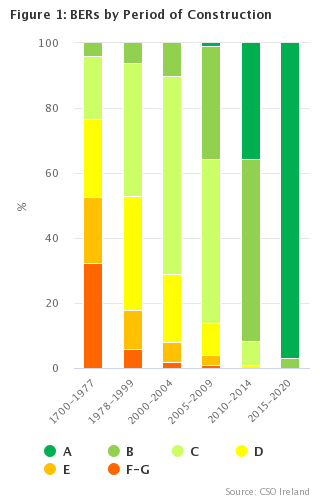
There were 20,995 Building Energy Rating (BER) audits reported in quarter one 2020 compared with 19,617 in January to March 2019 (see Table 1). This is an increase of 7% and could be due to factors such as an increase in new dwellings, updating of old BER certificates, and new renovation work.
Dwellings built in 2015-2020 were considerably more energy efficient than in earlier periods with 97% given an “A” rating compared with 35% in 2010-2014 and 1% in 2005-2009 (see Table A and Figure 1).
 Dublin County had the highest combined “A” and “B” rating at 30% (see Table 4). Roscommon had the lowest proportion of combined “A” and “B” rating at 8%.
Dublin County had the highest combined “A” and “B” rating at 30% (see Table 4). Roscommon had the lowest proportion of combined “A” and “B” rating at 8%.
Dublin 18, with an average dwelling age of 18 years, had the highest proportion of combined “A” and “B” rating at 43% (see Table 5). The average age of dwellings in Dublin 15 that have had a BER audit done was 17 years, but the combined “A” and “B” rating was much lower at 30% than in Dublin 18. The highest proportion of combined “F” and “G” rating was 26% for Dublin 7.
Mains gas was the main space heating fuel used in 51% of the dwellings completed during 2015-2020 and with a BER audit. This was a substantial increase from 2000-2004 when 41% of dwellings with a BER audit used mains gas. There were contrasting trends for heating oil and electricity with 35% of 2000-2004 built dwellings using heating oil compared with 4% for dwellings built in 2015-2020.
For more details and to view tables visit CSO.ie Domestic Building Energy Ratings
